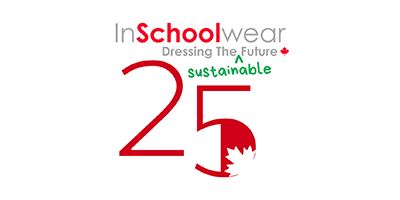During a long drive home from an environmentally focused field trip, the Eco Captains at Montcrest School started talking about what they could do—personally and as a school—to be more environmentally mindful. At one point during the conversation, the topic of their school uniform came up. What materials were the uniform pieces made of? Where were they manufactured and how far did the uniform travel to get to their homes? What impact did the uniforms have on the environment?
These student leaders didn’t know. So, they took a closer look, and they didn’t love what they found. "They had made an observation that they faded easily,” says Patti MacDonald, Head of School at Montcrest. “And that they tore easily." That was just the beginning. The material wasn’t durable, and it wasn’t made with any recycled or renewable sources. The uniforms weren’t sourced locally.
And then, the biggest question of all: “What do our uniforms say about us?” One of the values of the school, found right in its values statement, is to foster “a lifelong commitment to themselves, others, the Earth.” If the uniforms were made with non-renewable, non-recycled resources (they were), this had the potential to contradict their core values.
So, in partnership with staff and faculty, the students began researching their options, a process that led them to InSchoolwear. Founded in 1997, sustainability, as well as quality and style, has always been a goal for InSchoolwear, CEO, Kirstin Broach. Over the course of decades, as new options became available, this found its way into the offering. As of 2022, all pieces are part of their ECO-Uniform initiative, which includes fabric made of recycled water bottles.
“That has been the catalyst that has kept me going,” says Broach about the options she, and the students, were faced with. “How can we keep going and make everything more ethical? Everything fair trade? Everything recycled and recyclable?" she says. “All of this creates not only less energy at the beginning but the lifespan of the clothing is significantly longer."
In time Broatch accepted an offer to speak at the school. "When I went to meet with the students at Montcrest,” she says, “I realized they had done their research. They were against fast fashion.… I love that because they get, more than anybody, what I'm trying to achieve.”
For MacDonald, including the students in the process of developing a new uniform was an obvious one. “As the students say, ‘We're the ones who have to wear it, so we should definitely have input into its design.’” In many ways, the Montcrest students are engaging with clothing in much the same way Broatch did in founding the company. In 1995, she attended a sales party for a children’s clothing brand—the sales model was similar to Tupperware—and came away thinking, I can do better than that.
The kids at Montcrest thought that, too. But it’s also about agency, particularly among the students. A value of Montcrest, as included in the mission statement, is that “our school challenges children to discover and acknowledge their own voices, so they can understand and make meaningful connections with the world.”
As it grew, the uniform project fed into that—having a voice, a sense of agency, making connections. In partnership with Broatch, the students presented their findings to the school’s board, the parent association, and the student body. The next phase of the students' involvement was working with the visual arts department to research, ideate, and pitch new designs for the uniform collection using Montcrest’s brand identity…."[InSchoolwear] made a video about brand placement and the process by which InSchoolwear applies the branding and the guidelines that they've made,” says MacDonald. “So they've been incredibly supportive as we seek to allow this to be a very student-driven process.”
And then this: the Montcrest Parents’ Association, together with the Student Uniform Committee, recently hosted a fashion show to introduce the new uniform to its community. They invited Angela King, InSchoolwear’s VP of Sales and Operations to attend. “I was blown away by the students’ enthusiasm,” she says. “This is my first time working with a school where the change of uniform providers was led by the kids. They were involved in every step enthusiastically, and were so proud of themselves for what they did together for their school community.” As well they should be. When students look in the mirror each morning before school, they see more than they did even a year ago. They know where their uniform came from, how it was made, and what all of that means. They’ve learned something about the effects of their actions, both as individuals but also as part of a larger community. And they see, perhaps, some of the values that they hold and how they present those values, and themselves, to the world.
 |
| Kirstin Broatch | |
| 905-334-4545 | |
| [email protected] | |
| inschoolwear.com |